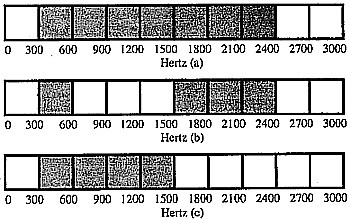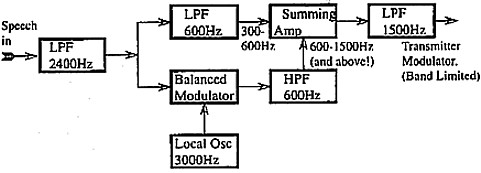 |
Introduction
The March 1995 issue of Amateur Radio included my article "An Adjustable Audio Filter System for the Receiver". This described a system using switched capacitor filters to provide continuous adjustment of lowpass, highpass, narrow bandpass and notch filter characteristics.In the June 1995 issue, I followed up with modifications to allow control of a wide band of frequencies that could be rejected or slotted out within the audio pass band.
Having experimented with the rejection band arrangement, I observed that there was little difference in speech quality if a complete band from 500 Hz to 1500 Hz was taken right out. Only frequencies below 500 Hz and above 1500 Hz seemed important for good intelligibility. I made the point in the article that if noise or interference was concentrated in the 500 to 1500 Hz spectrum, it could be reduced without loss of speech quality by simply slotting out this part of the audio spectrum.
I didn't think much more about this until I read the Pat Hawker Technical Topics column in January 1998 issue of Radcom. He described how in December 1977 issue of QST, Dr R W Harris and J C Gorski announced a new narrow band method of voice communication. The system made use of the characteristic of speech I have just discussed and audio frequencies in the range of 600 to 1500 Hz were not transmitted.
Narrow Band Voice Modulation (NBVM).
Pat Hawker further discusses how the system was perfected by R.W.Harris, WB6CZX and T.Lott, VE2AGF/W6. The theory of their system is illustrated in figure 1. Normal speech is transmitted around 300 to 2400 Hz as shown in Figure Ia. In NBVM, frequencies from 600 Hz to 1500 Hz are dropped out as shown in Figure lb. Frequencies between 1500 and 2400 are then shifted down to occupy the range of 600 to 1500 Hz as shown in Figure Ic. The complete audio band is thus reduced to a range from 300 to 1500 Hz.
 |
|
(a) Typical normal voice bandwidth used on SSB - 300 to 2400 Hz. |
|
(b) Audio range from 600 Hz to 1500 Hz deleted without loss of intelligibility. |
|
(c) 1500 to 2400 Hz speech spectrum shifted to replace 600 - 1500 Hz content. Total bandwidth is now 1500 Hz. |
| Source: Pat Hawkins - Technical Topics - Radcom Jan.1998 |
In effect the system emphasises the most important information bearing parts of speech (the consonants) but discards the mid range vowel sounds. On reconstruction of the frequency spectrum in reception, the original timbre and voice identification characteristics are retained.
So how is the system made to work? I found some reference in the 1982 issue of the ARRL handbook and this helped me assemble the block diagrams, figures 2 and 3, for the compander system.
 |
Transmission
Figure 2 shows how the speech bandwidth is compressed to feed into the transmitter. The speech is fed via a 2400 Hz low pass filter to restrict upper frequency, out of range, components. A 600 Hz low-pass filter separates the lower frequencies. The whole spectrum to 2400 Hz is fed to a balanced modulator to mix with a 3000 Hz local oscillator. Output components are removed from the modulator below 600 Hz by a low-pass filter. The 1500 to 2400 Hz input components to the modulator are converted at its output to a range of 1500 to 600 Hz but in addition there are a lot of other frequency components generated above 1500 Hz. All the modulator output components above 600 Hz are then summed with the 300 to 600 Hz components at the other leg and fed through a 1500 Hz low pass filter which eliminates the unwanted components above 1500 Hz. Our audio signal is now restricted to 1500 Hz bandwidth to feed the transmitter modulator.
Reception
At the receiving end, the audio output from the receiver is in the compressed bandwidth form and it must be expanded in a reverse process to restore intelligibility. This is illustrated in figure 3. The receiver audio is first fed through a 1500 Hz low pass filter to remove any higher frequency extraneous components. The frequencies below 600 Hz pass through the low pass filter while those above pass through the high pass filter. The output components from the high pass filter, above 600 Hz, are fed to a balanced modulator where they are mixed with a fixed 3000 Hz local oscillator.
 |
The 1500 to 600 Hz voice components are restored at the modulator output to their original frequency spectrum, 1500 to 2400 Hz. In addition there are also other output components above 2400 Hz resulting from the modulation process. The modulator output components are then summed with the 300 to 600 Hz components from the 600 Hz low pass filter. Finally, the combined signal is passed through a 2400 Hz low pass filter to remove the unwanted higher frequencies. We now have the restored signal that can be fed to the receiver loudspeaker.
System Features
So what are the advantages of NBVM? The introduction of single sideband reduced the bandwidth requirement to 50% of the old AM. The NBVM system reduces the bandwidth even further to 62% of SSB. Because of the reduction in bandwidth, we can fit more stations in a given band space and we can expect a nominal improvement in signal to noise ratio of around 2 dB.
The Technical Topics report indicates quite high speech quality with only the 1500 Hz transmission bandwidth. In fact the report further indicates that if intelligibility only is required, a bandwidth of 1200 Hz or even 1000 Hz is possible by using a rejection band of greater than the 600 to 1500 Hz discussed. My own tests using the tunable filters confirmed the good speech quality for a band rejection extending up to 1500 Hz but the tests also demonstrated the loss of quality as the rejection band was extended upward above 1500 Hz.
But what are the negatives? There is the complication of providing four fixed audio filters to transmit and four to receive. On the other hand, the filtering is all done at audio level and need not involve internal modification to transmitter or receiver. Of course in this day and age of modem digital technology, the whole filtering process could be easily achieved using digital signal processing techniques and indeed it might already have been incorporated in some of the modern digital signal processing gear.
Another factor is that if you decided to transmit with this system, you could only communicate with someone who had installed the corresponding audio receiving gear. Pat Hawker writes about the lack in popularity of NBVM in amateur radio circles. He said "These disadvantages have evidently been judged to outweigh the greater spectrum efficiency and fairly modest improvement in SNR."
As I said earlier, the principle of dropping out the speech components in the frequency range of around 500/600 Hz to 1500 Hz in the NBVM system tied in nicely with what I had found experimenting with my adjustable filter unit. I thought it would be an interesting subject to reintroduce to the columns of our AR journal.
References
1. Lloyd Butler VK5BR - An Adjustable Audio Filter System for the Receiver - Amateur Radio, March 1995.
2. Lloyd Butler VK5BR - The VK5BR Audio Filter, Modifications to include an Adjustable Rejection Band.
Amateur Radio, June 1995.
3. Pat Hawker G3VA - Technical Topics - Radcom, January 1998
4. ARRL Handbook, 1982 edition - Chapter 14, Specialised Communications Systems - Page 14-33